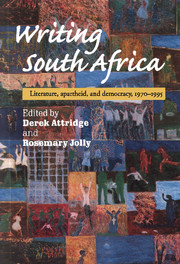Book contents
- Frontmatter
- Contents
- Contributors
- Acknowledgements and note on references
- South Africa, 1930–1996: a chronology
- Maps
- 1 Introduction
- 2 Interrogating silence: new possibilities faced by South African literature
- 3 I am dead: you cannot read: André Brink's On the Contrary
- 4 Endings and new beginning: South African fiction in transition
- 5 The post-apartheid sublime: rediscovering the extraordinary
- 6 Postmodernism and black writing in South Africa
- 7 Shame and identity: the case of the coloured in South Africa
- 8 A man's world: South African gay writing and the State of Emergency
- 9 The final safari: on nature, myth, and the literature of the Emergency
- 10 Interview
- 11 Speech and silence in the fictions of J.M.Coetzee
- 12 ‘Dialogue’ and ‘fulfilment’ in J.M. Coetzee's Age of Iron
- 13 Interview
- 14 Inside out: Jeremy Cronin's lyrical politics
- 15 Spinning out the present: narrative, gender, and the politics of South African theatre
- 16 South African theatre in the United States: the allure of the familiar and of the exotic
- Position papers
- Select bibliography: South African literary writing in English, 1970–1995
- Index
7 - Shame and identity: the case of the coloured in South Africa
Published online by Cambridge University Press: 05 July 2011
- Frontmatter
- Contents
- Contributors
- Acknowledgements and note on references
- South Africa, 1930–1996: a chronology
- Maps
- 1 Introduction
- 2 Interrogating silence: new possibilities faced by South African literature
- 3 I am dead: you cannot read: André Brink's On the Contrary
- 4 Endings and new beginning: South African fiction in transition
- 5 The post-apartheid sublime: rediscovering the extraordinary
- 6 Postmodernism and black writing in South Africa
- 7 Shame and identity: the case of the coloured in South Africa
- 8 A man's world: South African gay writing and the State of Emergency
- 9 The final safari: on nature, myth, and the literature of the Emergency
- 10 Interview
- 11 Speech and silence in the fictions of J.M.Coetzee
- 12 ‘Dialogue’ and ‘fulfilment’ in J.M. Coetzee's Age of Iron
- 13 Interview
- 14 Inside out: Jeremy Cronin's lyrical politics
- 15 Spinning out the present: narrative, gender, and the politics of South African theatre
- 16 South African theatre in the United States: the allure of the familiar and of the exotic
- Position papers
- Select bibliography: South African literary writing in English, 1970–1995
- Index
Summary
…Also: brown contains black – (?) – How would a person behave for us to say of him that he knows a pure, primary brown? We must always bear in mind the question: How do people learn the meaning of colour names?
wittgenstein, Remarks on ColourIn the 1980s South Africans discovered the Khoi/coloured woman Saartje Baartman, once known as the Hottentot Venus, who was exhibited in London and Paris from 1810 to her death in 1815. In nineteenth century Europe, as Sander Gilman points out, the display of her spectacular steatopygia and its generation of medical discourse on the Khoi genitalia established the iconographic link between the black woman and sexual lasciviousness (‘Black Bodies, White Bodies’, 216). Since the last decade has seen her well referenced in South African visual art and writing, popular outrage has moved the government to apply to France for the return of Baartman, whose remains are still held by the Musée de l'homme in Paris (though they were removed from public display in the 1980s). Having in the New South Africa become an icon of postcoloniality, Baartman's case can be seen as one of several initiatives towards reconstructing a national cultural past.
- Type
- Chapter
- Information
- Writing South AfricaLiterature, Apartheid, and Democracy, 1970–1995, pp. 91 - 107Publisher: Cambridge University PressPrint publication year: 1998
- 100
- Cited by



